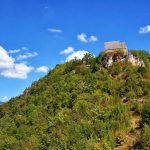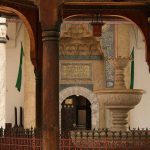The suburb of Vratnik is the oldest mahala (neighborhood) in Sarajevo and one of the rare ones which have managed to maintain their authenticity throughout the years. To this day, its residents proudly show the gates of Vratnik through which you used to be able to enter the city.

Until 1697, Sarajevo was an open city without defensive walls, which at that time was quite unusual. When Sarajevo was looted and burned down by the order of Prince Eugene of Savoy during that year, Gazi Ahmed Pasha Rustempašić decided that Sarajevo needed defensive walls.
Vratnik’s defensive walls, which had an irregular shape, surrounded the city which stretched out across 495596 square meters.
TOMBSTONES WITHIN DEFENSIVE WALLS
The construction of defensive walls around Vratnik lasted for twelve years. Based on the order of Gazi Ahmed Pasha Rustempašić, the defensive walls were supposed to be „a one-hour-walk-long, two yards thick, ten yards high”. Masons from Dubrovnik were in charge of the works, and the citizens of Sarajevo also helped build the walls. Legend says that there was an order for the stone to be removed from tombstones and built into the defensive walls, due to the fact that there were many graveyards in Sarajevo.
Within the defensive walls, there were five fortresses – White, Strošićka, Yellow or Jekovačka Fortress, Ravne Bakije Fortress and Zmajevac Fortress. The city also used to have three city gates and several smaller gates.
LEGEND OF HODIDJED FORTIFICATION
Today tourists from all over the world come to the fortresses to feel the unique spirit of Sarajevo and see the city that they will always remember. Tour guides tell them how the Sarajevo of today was founded in 1462 by Isa Bey Ishaković. They also tell them that the roots of the city were founded a lot earlier. However, very few tour guides in Sarajevo will tell them the story of the old Hodidjed fortification, which is thought to have existed back in the Middle Ages. The reason for that is that very little is known about it today. Alija Bejtić, the founder of the Institute for the Protection of Cultural and Historical Heritage, claimed that there was a fortification at Vratnik in Sarajevo in 1979. However, this was never proven. Some archaeologists claim that Hodidjed was situated on a cliff between the two Miljackas, while others believe that the fortification was situated at Bulozi, in today’s East Old Town Municipality, where there is a village of the same name today.
While very little is known about Hodidjed, the world knows plenty about the charm of Sarajevo’s fortresses. Some nine years ago, in 2010, scenes for the film “In the Land of Blood and Honey”, which was directed by Hollywood star Angelina Jolie, were filmed at the Yellow and White Fortress. Almost every year, filmmakers from all over the world gather at the Yellow Fortress during Sarajevo Film Festival.
ALIJA IZETBEGOVIĆ MUSEUM
Of the five fortresses, only two are in good condition – the Yellow and White Fortress, and the only completely preserved part of a defensive wall is the one between the city gates Ploča and Širokac, which is today, along with those two city gates, a part of Alija Izetbegović Museum, the first president of Bosnia and Herzegovina.
The museum was opened after his death, in 2007 within these gates, which are located above the Martyrs’ Cemetery of Kovači. Among other things, you can find books written by him at the museum, photographs which speak of his character and work, you can see the most significant awards and accolades that he has received, and the uniforms of soldiers from the beginning and the end of the war in Bosnia and Herzegovina have also been exhibited here. Old Town Vratnik was declared a National Monument of Bosnia and Herzegovina in 2005.




